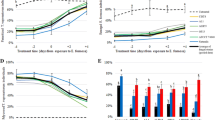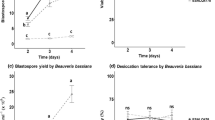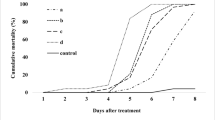Abstract
The virulence of three isolates of Beauveria bassiana (Bals.) Vuill. and 23 isolates of Metarhizium anisopliae (Metschnik.) Sorok. (Ascomycota: Hypocreales) against the tomato spider mite, Tetranychus evansi Baker and Pritchard (Acari: Tetranychidae), was assessed in the laboratory. The effect of temperature on germination, radial growth and virulence of selected isolates (two isolates of B. bassiana and nine of M. anisopliae) on T. evansi was also investigated in the laboratory. All the fungal isolates tested were pathogenic to the adult females of T. evansi, and there were significant differences in mortality between fungal isolates. The lethal time to 50% mortality (LT50) values ranged from 4.2 to 8.1 days and the LT90 values from 5.6 to 15.1 days. Temperature had significant effects on germination, radial growth and virulence of the various isolates. The best fungal germination was observed at 25 and 30°C, while for the fungal radial growth it was 30°C. All the isolates germinated and grew at all temperatures, but germination and radial growth varied with isolate and temperature. The selected isolates were all virulent to T. evansi, but virulence varied also with isolate and temperature.
Similar content being viewed by others
References
Abbott WS (1925) A method of computing the effectiveness of an insecticide. J Econ Entomol 18:265–267
Alves SB, Tamai MA, Rossi LS, Castiglioni E (2005) Beauveria bassiana pathogenicity to the citrus rust mite Phyllocoptruta oleivora. Exp Appl Acarol 37:117–122
Barreto RS, Marques EJ, Gondim MGC Jr, de Oleivera JV (2004) Selection of Beauveria bassiana (Bals.) Vuill. and Metarhizium anisopliae (Metch.) Sorok. for the control of the mite Mononychellus tanajoa (Bondar). Sci Agr 61:659–664
Benz S (1987) Environment. In: Fuxa JR, Tanada Y (eds) Epizootiology of insect diseases. Wiley, New York, pp 177–214
Blair BW (1983). Tetranychus evansi Baker and Pritchard (Acari: Tetranychidae); a new pest of tobacco in Zimbabwe. In: CORESTA phytopathology and agronomy study group. Bergerac, France, p 1
Bonato O (1999) The effect of temperature on life history parameters of Tetranychus evansi (Acari: Tetranychidae). Exp Appl Acarol 23:11–19
Brooks A, Wall R (2005) Horizontal transmission of fungal infection by Metarhizium anisopliae in parasitic Psoroptes mites (Acari: Psoroptidae). Biol Control 34:58–65
Burgerjon A (1956) Pulvérisation de poudrage au laboratoire par des préparations pathogènes insecticides. Ann Epiphyt 4:677–688
Chandler D, Davidson G, Pell JK, Ball BV, Shaw K, Sunderland KD (2000) Fungal biocontrol of Acari. Biocontrol Sci Technol 10:357–384
Chandler D, Davidson G, Jacobson RJ (2005) Laboratory and glasshouse evaluation of entomopathogenic fungi against the two-spotted spider mite, Tetranychus urticae (Acari: Tetranychidae), on tomato, Lycopersicon esculentum. Biocontrol Sci Technol 15:37–54
de Moraes GJ, McMurtry JA (1986) Suitability of the spider mite Tetranychus evansi as prey for Phytoseiulus persimilis. Entomol Exp Appl 40:109–115
de Moraes GJ, De Souza Ramalho F, de Oliveira CAV, Freire LC (1986) Artropodos associados ao tomateiro industrial em Petrolina, PE e racionalizacao do uso de defensivos agricolas. Bol Pesq EMPRABA 28:28p
Dimbi S, Maniania NK, Lux SA, Mueke JM (2004) Effect of constant temperatures on germination, radial growth and virulence of Metarhizium anisopliae to three species of African tephritid fruit flies. Biocontrol 49:83–94
Duverney C, Kade N, Ngueye-Ndiaye A (2005) Essais préliminaires pour limiter les dégâts de Tetranychidae sur les cultures maraîchères dans le Sine-Saloum (Sénégal). In: Annales comptes rendus de deuxième colloque international sur les acariens des cultures de l’AFPP, Montpellier, France, 24–25 October 2005
Ekesi S, Maniania NK, Ampong-Nyarko K (1999) Effect of temperature on germination, radial growth and virulence of Metarhizium anisopliae and Beauveria bassiana on Megalurothrips sjostedti. Biocontrol Sci Technol 9:177–185
Escudero LA, Ferragut F (2005) Neoseiulus californicus and Phytoseiulus persimilis (Acari: Phytoseiidae) on four spider mite species as prey, with special reference to Tetranychus evansi (Acari: Tetranychidae). Biol Control 32:378–384
Ferragut F, Escudero LA (1999) Tetranychus evansi Baker & Pritchard (Acari, Tetranychidae), una nueva araña roja en los cultivos hortícolas españoles. Bol Sanid Veg Plagas 25:157–164
Furtado IP, Moraes GJ, De Kreiter S, Garcin M-S, Knapp M (2007) Potential of a Brazilian population of the predatory mite Phytoseiulus longipes as a biological control agent of Tetranychus evansi (Acari: Phytoseiidae, Tetranychidae). Biol Contr 42:139–147
Gutierrez J, Etienne J (1986) Les Tetranychidae de l’île de la Réunion et quelques-uns de leurs prédateurs. Agron Trop 41:84–91
Inglis DG, Goettel MS, Butt TM, Strasser H (2001) Use of hyphomycetes fungi for managing insect pests. In: Butt TM, Jackson C, Magan N (eds) Fungi as biocontrol agents: progress, problems and potential. CABI International, Wallingford, pp 23–69
Kaaya GP, Mwangi EN, Ouna E (1996) Prospects for biological control of livestock ticks, Rhipicephalus appendiculatus and Amblyomma variegatum, using the entomogenous fungi Beauveria bassiana and Metarhizium anisopliae. J Invertebr Pathol 67:15–20
Kiewnick S (2006) Effect of temperature on growth, germination, germ-tube extension and survival of Paecilomyces lilacinus strain 251. Biocontrol Sci Technol 16:535–546
Kreiter S, Auger P, Lebdi Grissa K, Tixier MS, Chermiti B, Dali M (2002) Plant inhabiting mites (Acari: Prostigmata and Mesostigmata) of some northern Tunisian crop. Acarologia 42:389–402
Ouedraogo A, Fargues J, Goettel MS, Lomer CJ (1997) Effect of temperature on vegetative growth among isolates of Metarhizium anisopliae and M. flavoviride. Mycopathologia 137:37–43
Pĕna JE, Osborne LS, Duncan RE (1996) Potential of fungi as biocontrol agents of Polyphagotarsonemus latus (Acari: Tarsonemidae). Entomophaga 41:27–36
Ramalho FS, Flechtmann CHW (1979) Niveis de infestacao de Tetranychus (T.) evansi Baker, Pritchard, 1960 em diferentes fases de desenvolvimento do tomateiro. Rev Agric 54:51–56
Rapilly F (1968) Les techniques de mycologie en pathologie végétale. Ann Epiphytol 19, HS, 102 p
Samish M, Gindin G, Alekseev E, Glazer I (2001) Pathogenicity of entomopathogenic fungi to different developmental stages of Rhipicephalus sanguineus (Acari: Ixodidae). J Parasitol 87:1355–1359
SAS Institute (1999–2001) SAS/STAT User’s Guide. Version 8.01. SAS Institute Inc., Cary
Saunyama IGM, Knapp M (2003) Effect of pruning and trellising of tomatoes on red spider mite incidence and crop yield in Zimbabwe. Afr Crop Sci J 11:269–277
Shaw KE, Davidson G, Clark SJ, Ball BV, Pell JK, Chandler D, Sunderland KD (2002) Laboratory bioassays to assess the pathogenicity of mitosporic fungi to Varroa destructor (Acari: Mesostigmata), an ectoparasite mite of the honeybee, Apis mellifera. Biol Control 24:266–276
Silva P (1954) Um novo acaro novico ao tomateiro na Bahia (Tetranychus marianae McGregor, 1950-Acarina). Bol Inst Biol Bahia 1:18–37
Smith Meyer MKP (1996) Mite pests and their predators on cultivated plants in Southern Africa: vegetables and berries. ARC-Plant Protection Research Institute, Pretoria
Soper RS, Ward MG (1981) Production, formulation and application of fungi for insect control. In: Papavizas GC (ed) Biological control in crop production, BARC Symposium No. 5. Allanheld, Osmun, Totowa, pp 161–180
Stokes ME, Davis CS, Koch GG (2000) Categorical data analysis using the SAS system. SAS Institute Inc., Cary
Tamai MA, Alves SB, Almeida JEM, Faion M (2002) Evaluation of entomopathogenic fungi for control of Tetranychus urticae Koch (Acari: Tetranychidae). Arq Inst Biol 69:77–84
Tefera T, Pringle K (2003) Germination, radial growth, and sporulation of Beauveria bassiana to Chilo partellus (Lepidoptera: Pyralidae) at different temperatures. Biocontrol Sci Technol 13:699–704
Thomas MB, Jenkins NE (1997) Effects of temperature on growth of Metarhizium flavoviride and virulence to the variegated grasshopper, Zonocerus variegatus. Mycol Res 101:1469–1474
Wekesa VW, Maniania NK, Knapp M, Boga HI (2005) Pathogenicity of Beauveria bassiana and Metarhizium anisopliae to the tobacco spider mite Tetranychus evansi. Exp Appl Acarol 36:41–50
Acknowledgments
The authors are grateful to Drs. N. Jiang and F. Schultess (ICIPE) for reviewing the first draft of the manuscript. The authors are also grateful to A. Wanjoya for statistical advice and Ms. E.O. Ouna, Mr. R. Rotich, Mr. C. Kyallo and Mr. B. Muia for technical assistance. This study received financial support from the SII-Dutch government fund through the African Regional Postgraduate Programme in Insect Science (ARPPIS) of ICIPE and from the German Federal Ministry for Economic Cooperation and Development (BMZ).
Author information
Authors and Affiliations
Corresponding author
Rights and permissions
About this article
Cite this article
Bugeme, D.M., Maniania, N.K., Knapp, M. et al. Effect of temperature on virulence of Beauveria bassiana and Metarhizium anisopliae isolates to Tetranychus evansi . Exp Appl Acarol 46, 275–285 (2008). https://doi.org/10.1007/s10493-008-9179-1
Received:
Accepted:
Published:
Issue Date:
DOI: https://doi.org/10.1007/s10493-008-9179-1




